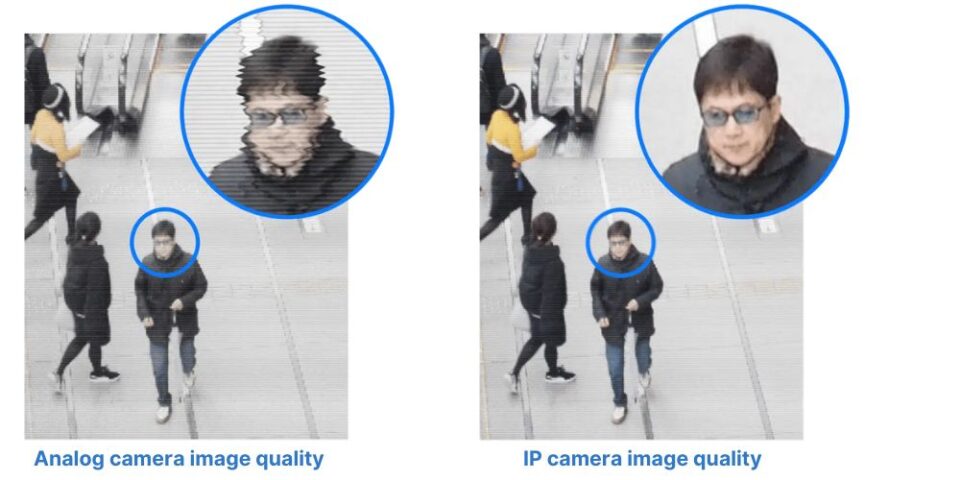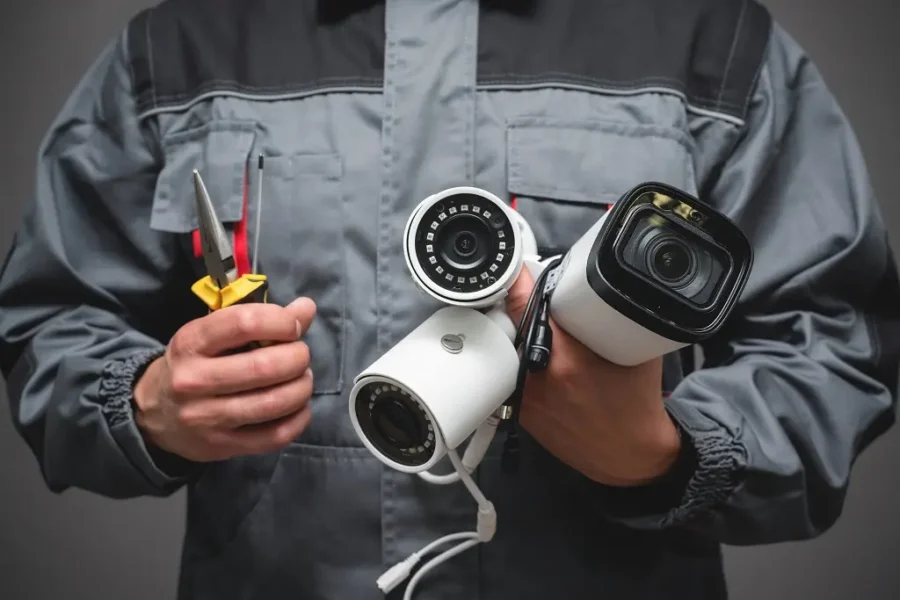When it comes to setting up a surveillance system, one of the most critical decisions you’ll face is choosing between Analog CCTV cameras and IP cameras. Both technologies have their strengths and weaknesses, and understanding these can help you make an informed decision tailored to your specific needs. In this comprehensive guide, we’ll delve into the differences between Analog and IP cameras, exploring aspects such as image quality, installation complexity, scalability, cost, and overall performance.
Read more: Top CCTV Camera Technology Trends in 2024

Table of Contents
ToggleWhat is Analog CCTV Cameras?
Analog Closed-Circuit Television (CCTV) cameras have been around for decades and are a well-established technology in the security industry. They capture video images and transmit the signal over coaxial cables to a Digital Video Recorder (DVR), which processes and stores the footage.
Key Characteristics:
- Resolution: Typically ranges from 704×480 (D1) to 960×480 (960H).
- Transmission: Uses analog signals transmitted via coaxial cables.
- Recording Device: DVR.
- Installation: Relatively simple but can be cumbersome due to extensive cabling.
What is IP Cameras?
Internet Protocol (IP) cameras are a more recent development in surveillance technology. These cameras capture and process video data, then transmit it over a network using internet protocols. The video can be recorded on a Network Video Recorder (NVR) or stored in the cloud.
Key Characteristics:
- Resolution: Can go up to 4K and beyond, offering superior image quality.
- Transmission: Uses digital signals transmitted via Ethernet cables.
- Recording Device: NVR or cloud storage.
- Installation: Can be more complex but offers greater flexibility.
Comparing Analog CCTV Cameras and IP Cameras
Image Quality
Analog CCTV Cameras: Analog cameras traditionally offer lower resolution compared to their IP counterparts. While advancements have been made with technologies like HD-CVI, HD-TVI, and AHD, which can deliver up to 1080p resolution, they still lag behind the ultra-high-definition capabilities of IP cameras. Analog cameras might suffice for basic surveillance needs but can struggle in environments requiring detailed image clarity, such as facial recognition or license plate reading.
IP Cameras: IP cameras excel in image quality, with resolutions starting from 720p and going up to 4K and beyond. This high resolution provides crisper, clearer images, making it easier to identify fine details. Additionally, IP cameras often come with advanced features like Wide Dynamic Range (WDR), which enhances image quality in challenging lighting conditions, and digital zoom capabilities, which allow for better focus on specific areas without losing clarity.

Installation Complexity
Analog CCTV Cameras: Installing analog CCTV systems can be relatively straightforward, especially in smaller setups. However, the extensive cabling required for each camera to connect directly to the DVR can become cumbersome in larger installations. This also makes the system less flexible when it comes to expanding or relocating cameras.
IP Cameras: IP cameras offer more flexibility in terms of installation. They can be connected via standard Ethernet cables and can often be powered through Power over Ethernet (PoE), which simplifies cabling by allowing a single cable to transmit both power and data. While the initial setup might be more complex due to network configuration, the scalability and ease of adding new cameras or relocating existing ones make IP systems more adaptable to changing needs.
Scalability
Analog CCTV Cameras: Scalability can be a significant limitation for analog systems. Adding new cameras requires additional cabling and potentially upgrading the DVR to accommodate more channels. This can quickly become impractical and expensive in larger installations or as the need for surveillance grows.
IP Cameras: IP systems are inherently more scalable. As long as there is network infrastructure in place, adding new cameras is relatively simple. Most NVRs can support numerous cameras, and the use of network switches can further extend the system’s capacity. This flexibility makes IP cameras a better choice for growing businesses or large-scale surveillance projects.
Cost
Analog CCTV Cameras: Analog systems are generally less expensive upfront. The cameras and DVRs tend to be cheaper, and for small installations, the cost of cabling and installation is also lower. However, these savings can diminish in larger setups due to the increased cost and labor associated with extensive cabling.
IP Cameras: While the initial investment for IP cameras and NVRs can be higher, the overall cost can be more favorable in the long run, especially for larger systems. The reduced cabling requirements and the ease of scalability contribute to lower installation and expansion costs. Additionally, IP systems often come with advanced features that can provide added value and enhanced security.
Performance and Features
Analog CCTV Cameras: Analog cameras provide basic surveillance capabilities. They are reliable and effective for standard security needs but lack advanced features found in IP cameras. Some analog systems have incorporated digital technologies to improve performance, such as hybrid DVRs that can accept both analog and IP camera inputs.
IP Cameras: IP cameras offer a wide range of advanced features that enhance their performance and usability. These include:
- Remote Access: View and manage footage from anywhere with an internet connection.
- Advanced Analytics: Motion detection, facial recognition, and other AI-driven features.
- High Frame Rates: Smoother video, particularly useful for monitoring fast-moving objects.
- Integration Capabilities: Can easily integrate with other security systems and smart devices.
Reliability and Security
Analog CCTV Cameras: Analog systems are generally considered highly reliable due to their simplicity. However, they are more vulnerable to signal interference and degradation over long distances. Security can also be a concern as analog signals can be intercepted or tampered with more easily than encrypted digital signals.
IP Cameras: IP cameras offer robust security features, including encryption and secure data transmission protocols. This makes them less susceptible to tampering and unauthorized access. However, they can be more complex to secure, requiring proper network security measures to protect against cyber threats.
Practical Use Cases
Analog CCTV Cameras:
- Small Businesses: Ideal for small to medium-sized businesses where high resolution is not critical.
- Budget-Conscious Projects: Suitable for projects with tight budgets where advanced features are not necessary.
- Simple Installations: Effective for straightforward setups with minimal cabling requirements.
IP Cameras:
- Large Enterprises: Best for large-scale installations needing high resolution and advanced features.
- High-Security Areas: Ideal for locations requiring detailed surveillance and advanced analytics.
- Scalable Systems: Perfect for businesses expecting to expand their surveillance needs over time.
Read more: CCTV Cameras vs. Alarm Systems: Which is Better for Home Security

Conclusion
Choosing between Analog CCTV cameras and IP cameras depends on various factors including your specific security needs, budget, and the scale of the installation. Here’s a summary to help guide your decision:
Choose Analog CCTV Cameras if:
- You have a limited budget and need a cost-effective solution.
- Your installation is small to medium-sized, and high resolution is not a priority.
- You prefer a simpler setup with straightforward technology.
Choose IP Cameras if:
- You require high-resolution images and advanced features like remote access and analytics.
- Your installation is large or expected to grow, necessitating a scalable solution.
- You want to integrate with other security systems and smart devices.
Ultimately, both analog and IP cameras have their place in the surveillance landscape. By carefully assessing your requirements and understanding the strengths and limitations of each technology, you can select the system that best meets your security needs. Whether you prioritize cost, image quality, scalability, or advanced features, there’s a solution available to ensure your property remains safe and secure.
Let’s explore some CCTV Cameras products now!
